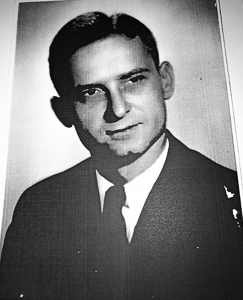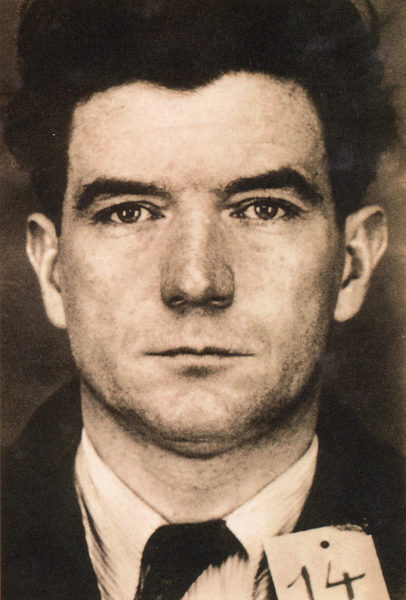
As his body plummeted towards the Normandy landscape at 250 feet per second, Sgt. Hilliard was likely praying to God that his chute would open. He had been trained to clear the plane before pulling the cord. Sgt. Hilliard saw for only an instant that several of his crew mates managed to jump out of the damaged aircraft before it began its downward spiral and broke in two. Glancing up, he figured enough time had gone by to clear the damaged bomber. He pulled the cord and felt a rush of excitement and relief when the chute opened and caught the wind to slow down his descent. Those feelings were short-lived. Now he realized that he was at risk of being shot by the Luftwaffe attack fighters such as the Messerschmitt Me-109s and the Fw-190s or killed by the German’s anti-aircraft guns’ flak which had crippled his aircraft and worst of all, he had absolutely no control over the situation.
This is the story and fate of the top turret gunner, Hilton G. Hilliard (1920−1985), and the crew on the B-17F Heavy Bomber which was shot down over France on the evening of 29 May 1943.
Did You Know?
The 1949 film Twelve O’Clock High tells the story of the aircrews of the United States Army’s Eighth Air Force. Although a fictional story (the main character portrayed by Gregory Peck, Frank Savage, is loosely based on Colonel Frank Armstrong, who commanded the 306th Bomb Group), the film was generally recognized by the former combat crews as one of the most realistic portrayals of the B-17, its crew, and the hazardous missions flown out of a fictional English airfield called Archbury. For those of you who have seen the movie, you’ll remember it starts in post-war London when former Major Stovall (Dean Jagger) finds the Robin Hood toby mug in an antique shop. He purchases the mug, sets it in the basket of his bicycle, and peddles out to a country lane. Stovall stops next to a fence, gets off his bike, and gazes out to what is clearly a dilapidated airfield and flight tower. The scene then fades out and morphs into World War II as the American B-17s are taking off for daylight bombing raids into Germany. The field he is looking at is the former RAF Chelveston airfield, base for the 305th Bomb Group and its four bomb squadrons including Sgt. Hilliard’s squadron. Today, the airfield has been developed into a renewable energy field. However, you can see traces of the old airfield when comparing the 1944 aerial photo to a current image.
Let’s Meet Hilton G. Hilliard
Hilton Hilliard was born in 1920 in South Carolina. His parents, William and Ruth Hilliard, moved their family of three boys and two girls to Dublin, Georgia where, except for his war years, Hilton spent his entire life. He was not quite six feet tall but had blonde hair and green eyes. Hilton was very handsome and could easily have been mistaken for one of Hollywood’s leading actors. In order to help support the family, Hilton dropped out of school after finishing eighth grade. A series of jobs led to his last vocation as a lathe turret operator prior to his enlistment.
Once war was declared against Germany and Japan after the attack on Pearl Harbor, the three Hilliard boys enlisted (Edward in the Navy and Lanier in the Army). Enlisting on 10 February 1942 at Fort McPherson in Atlanta, Georgia, Private Hilton Hilliard was sent to U.S. Army Air Forces basic training for six weeks. The smart guys volunteered for aerial gunnery school because they knew it was the quickest way for a non-com to earn extra stripes and an increase in pay grade. After his training, Pvt. Hilliard was assigned to the Eighth Air Force and followed his unit from base to base until they were transferred to England and assigned to their permanent airfield, RAF Chelveston. See the Chelveston memorial here. Read More Rendezvous With The Gestapo

